Archaeological excavations in Kaiseraugst, located in northern Switzerland, have revealed a remarkably well-preserved Roman road, infant graves, and a collection of rare ancient artifacts. These findings shed light on daily life and urban planning in Augusta Raurica, one of the best-preserved Roman settlements north of the Alps.
Aargau Cantonal Archaeology Department stated:
“This discovery offers a rare and powerful glimpse into the architectural and social fabric of Roman urban life.”
A Roman Road with Porticoes and Urban Planning Mastery
The excavated Roman road, about 4 meters (13 feet) wide, features drainage ditches and was flanked by columned porticoes. This structure stands as a testament to the advanced infrastructure and urban design of the Roman Empire.
Adjacent to the road, archaeologists unearthed the remains of two strip houses, narrow dwellings common in Roman provinces. These houses opened directly onto the street, underscoring the importance of the road in the community’s daily life.

Infant Burials Discovered in House Courtyards
In the backyards of the strip houses, stone-lined shafts believed to be either toilets or storage pits were found to contain infant burials. Such home burials were not uncommon in the Roman world, especially due to high infant mortality.
Archaeologist’s note:
“These burials are both touching and telling. They reflect familial care as well as practical customs in Roman domestic life.”
Rare Finds: Bronze Panther Figurine and Mosaic Glass Spindle
Among the most fascinating discoveries is a small bronze panther figurine, alongside a mosaic glass spindle whorl and a tuff stone offering stand. These items provide deep insight into the craftsmanship, religious practices, and personal lives of Augusta Raurica’s inhabitants.
Excavation lead:
“Such artifacts are extremely rare. The bronze panther may have symbolized strength or status in Roman society.”

Digital Archaeology: Schürmatt Becomes a Model
The Schürmatt excavation marks a milestone as the first fully digitally documented archaeological project by the Aargau Cantonal team. All data was recorded on-site using digital tools and uploaded directly to a central database.
“This digital-first method could set a new standard for future excavations across Switzerland.”
With these findings, scholars now have a richer understanding of urban life, architecture, and rituals in Roman Augusta Raurica. The site remains one of the most intact Roman cities north of the Alps — a living laboratory for Roman archaeology.
Cover Image Credit: Kanton Aargau





